There are between sixty (60) and two hundred (200) species in the genus Calathea, or types of calathea. These flowering plants have ornamental leaves, and sometimes colorful flowers. They can also provide dwellings for arthropods.
Calatheas, or prayer plants, are tropical flowering plants that belong to the genus Calathea and the biological family Marantaceae and are classified as perennial rhizomatous or tuberous herbs. They are common as pot plants (plants that are suitable for growing, especially indoors, in flower pots).
Leaves of calatheas are typically large and brightly colored. Some such colors include red, white, purple, orange and pink. The flowers may be white, yellow or purple in color, and they blossom in summer time.
The leaves of these plants display nyctinasty, which involves a plant responding to darkness by “sleeping”. The leaves do this by furling in the night and then unfurl in the morning when the sun comes up.
Calatheas are popular for indoor office decoration purposes. It is often used in homes and businesses as well. It is a type of plant that prefers indirect lighting, which makes it perfect for indoor usage and office buildings.
Listed below are eleven (11) common types of calathea and fourteen (14) rare types. The popular ones are discussed with their physical descriptions, how best to grow them, and other useful facts about the plants.
Table of Contents
Common Types of Calathea
1. Calathea albertii

This is commonly known as Albert’s prayer plant, white tiger calathea or emerald feather calathea. The plant has large leaves which are dark green in color. The leaves have light green markings resembling patterns on a feather.
The rugged and beautiful plant is known for its striking and peculiar leaves. It may grow to about 25 to 30 cm (10 to 12 in). Like other calatheas, Albert’s prayer plants are able to grow indoors with medium to low light and natural ventilation.
It does not require direct sunlight as this can scorch the leaves, but due to its tropical origins, it needs wet soil that can retain moisture. Peat and perlite make a suitable and rich soil when mixed in adequate proportions.
Albert’s prayer plants should however be grown in pots that have drainage holes to avoid them sitting in water. They need to be watered regularly, once or twice a week. If the top two inches of the soil start drying out however, water your plant.
A moisture meter is a good tool used to measure the soil’s moisture level. It can help with knowing when your plant requires watering. Use unfiltered water in place of tap water for your plant in order to avoid scorching the leaves.
This type of calathea, like other types, does not like dry air. It is a requirement that your home or office be humid. You can increase the humidity around it by using a humidifier or placing it in your bathroom.
Another way to increase humidity is by putting your plant in a watered tray containing pebbles and then laying containers of water around your plants. Albert’s prayer plants also like warmth and stable temperatures throughout the year.
Furthermore, keep your plant way from windows and doors to avoid direct sunlight, and from heating systems to avoid exceeding high temperatures. Both are detrimental to the calathea as they scorch its leaves.
2. Calathea anulque
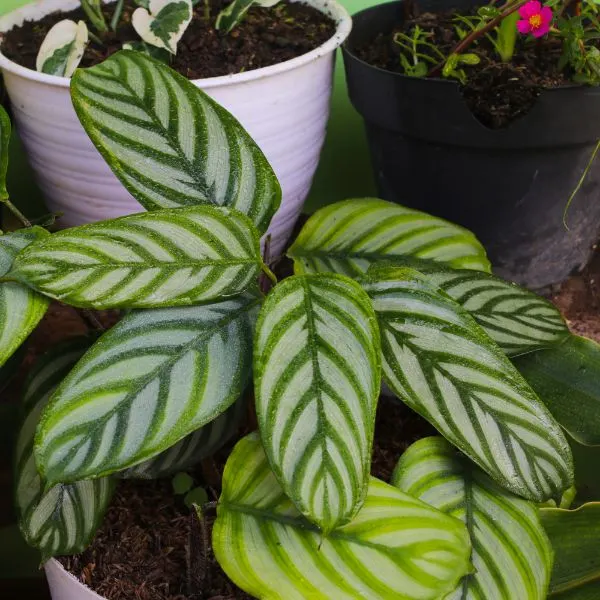
Calathea anulque is native and endemic to Ecuador and Colombia. Like other calathea species, it is a tropical plant.
The leaves of this particular type of calathea may begin to fall should the plant not receive adequate sunlight. To solve this problem, your plant should be kept about 3 feet away from a window, preferably one that faces south.
For its moisture needs, the plant does require frequent watering. However, unlike Calathea albertii, Calathea anulque prefers that its soil be dried out before it is watered again, but definitely not too dry.
The plant requires good, well draining soil. You may add perlite or vermiculite to your regular potting soil to enhance drainage. It does not require additional humidity and the best way to provide it with humidity is by watering the soil.
You should repot your plants when it has used up the nutrients in the potting soil. A good way to gauge this is by the size of the plant. If your plant has doubled in size, it is most likely time to change its pot and soil.
However, even if your Calathea anulque has not doubled in size, it should be repotted once a year. This helps to restore and refresh the nutrients that your plant needs. As long as this happens, the soil does not require fertilizer.
3. Calathea crocata

This type of calathea is more commonly referred to as the eternal flame. This is because of its beautiful yellow and orange flowers which make the eternal flame all the more colorful. The plant is native to Brazil and tropical America.
Its leaves are slightly wrinkled. They are colored a metallic green on the outside and streaked with purple. Underneath, they are brown with purple streaking as well. It is an indoor plant that looks most stunning when its flowers are in bloom.
Eternal flames are most adequately grown in bright spaces without direct sunlight touching them. This is because if direct sunlight comes in contact with the plant for a prolonged period of time, the color of the leaves may fade away.
The species requires frequent watering especially during the warmer periods of the year. This watering should be regular and the amount of time etween waterings should be fairly even. The frequency however depends on the soil type.
Ideally, the potting soil used to grow eternal flame calatheas contains about 25% of peat moss. It is imperative that the soil does not retain too much water and is able to drain easily. This is facilitated by using pots with drainage holes.
Although calatheas of this type do not like direct sunlight, they require heat, humidity and warmth. They prefer stable and consistent temperature levels. They also do well in spaces at room temperature provided the area is humid.
Misting is a good technique to apply when growing eternal flames, preferably every day with room temperature water. In the absence of adequate humidity, the leaves of the plants may be affected by brown spots.
It is not required that you use fertilizer for your plant’s soil but if you would prefer to, use standard liquid fertilizer every two weeks while the plant is still in its early stages of growth. The plant may be repotted once a year, better in the summer.
4. Calathea crotalifera
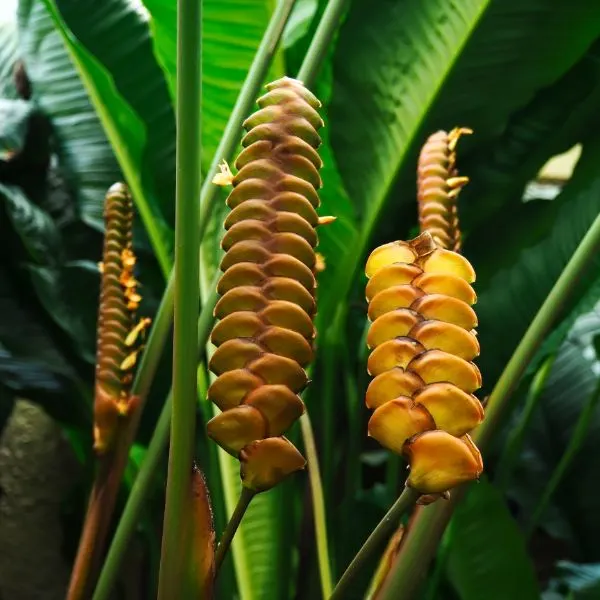
Also biologically referred to as Calathea isignis, this plant is also known in English by common names such as: rattlesnake plant, rattle shaker, rattlesnake ginger and yellow rattleshaker.
It is also called serpent à sonnette in French; cascavel or caetê-guizo-de-cascavel in the Portuguese-Brazil areas; bijagua, bijagüillo, cascabel, hoja blanca or hoja de sal in Spanish; and klappers-chlangenpflanze in German.
The Calathea crotalifera species is native to tropical America, in such countries as Bolivia, Brazil, Colombia, Costa Rica, Ecuador, Guatemala, Honduras, Mexico, Nicaragua, Panama, Peru and Venezuela.
Its leaves are broad, long, pointed and egg-shaped. They are colored a glossy shade of green above and a pale or grayish green with purple streaks or margins below. These oval leaves are supported by long leafstalks.
The plant’s inflorescence consists of two adjacent lines of yellow boat-shaped bracts that are tightly stacked, resembling the tail of a rattlesnake. This inflorescence may be up to 25 cm (9.8 in) long.
These bracts have thin and tubular flowers with three lobes. The flowers are typically greenish yellow or yellowish white in color. The entire plant may grow up to 30 cm (11.8 in) long. It requires warmth and constant, consistent humidity levels.
Rattlesnake plants need soil that is rich in nutrients and drains easily for maximal growth. To improve the drainage capacity of the soil, you can add in coarse siliceous sand or perlite to your plant pot.
The species also need to be placed in a bright room with an indirect source of sunlight. Water your plant regularly in the warmer months and space watering in colder months to let the top part of the soil dry a little before it is watered again.
If the plant is exposed to dry air or watered with unfiltered water, its leaves may begin to have brown spotting. It produces dry and dehiscent (that open spontaneously at maturity to release seeds) fruits containing dark blue seeds.
5. Calathea fasciata
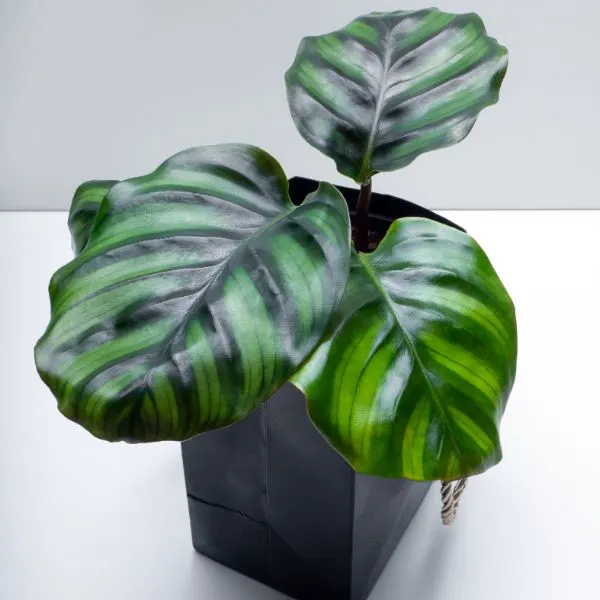
This type of calathea was formerly called Calathea rotundifolia or Calathea rotundifolia fasciata. It is a popular and common species with large, round and shiny leaves. It is a very beautiful and attractive ornamental plant.
On top, the leaves are green and have dark green veins on them. Underneath them, their color is a deep burgundy or purple. It is a good indoor plant as well as a garden plant. It is well adapted to life outdoors.
Calathea fasciata is typically around 20 to 65 cm (8 to 25.6 in) tall. Some plants with excellent growing conditions and care have grown up to 75 cm (29.5 in). A mature leaf may be about 5 to 6 cm (2 to 2.4 in) long and 5 cm (2 in) wide.
Like other calathea species, this one needs to be watered consistently and regularly. The top 4 inches off the soil should be dry before you add water again (and this can be detected by a moisture meter) as soggy soil attracts fungi and mold which are not good for your plant.
In addition to steady water supply, this type of calathea requires soil that has capacity to retain water (is moist) but drains easily as well (is porous). To help with draining water from the soil, ensure your pot has a hole or holes in it.
To avoid browning and burning the leaves, do not expose the plant to direct sunlight for prolonged periods. Place it under shade if it is growing outside. Bright but indirect and uniform sunlight is adequate for those growing indoors.
Owing to its tropical origins, Calathea fasciata requires warm temperature and a humid environment. If the air is dry, you can use a humidifier in the room, or mist the plant mildly to make it more moist and humid.
This plant grows quickly so it may fill the pot quickly fill your pot. Repotting once a year is good for the plant’s health. It must be done carefully, as well as frequent pruning to keep the plant looking neat and tidy.
6. Calathea lancifolia
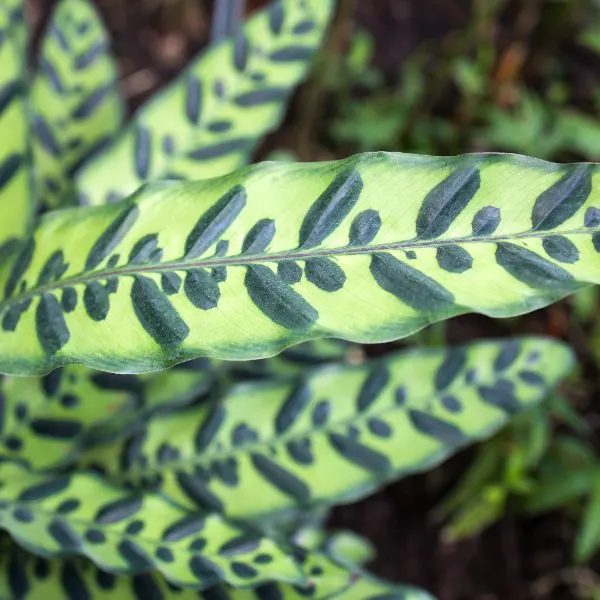
Native to Rio de Janeiro in Brazil, Calathea lancifolia is also called the rattlesnake plant, like Calathea crotalifera. It is an evergreen species that possesses unique long and slender leaves with ruffled edges.
Above, the leaves are bright green in color and are heavily patterned with dark green markings. Their underside is purple. While the leaves may grow up to 45 cm (18 in) wide, the entire plant is usually 60 to 75 cm (24 to 30 in) long.
Calathea lancifolia prefers indirect sunlight. It should be placed in a luminous room where sunlight does not directly touch it. This is to avoid browned leaves that result from the sun scorching the plant.
The leaves also catch dust easily. They should be gently wiped frequently with a soft, moist cloth. This type of calathea likes warm temperature and humidity levels. Misting the plant regularly and keeping it in the bathroom help humidity levels.
The plant’s soil requirements are similar to other species’. It needs moist soil that has adequate drainage capacity as well. The potting soil should contain peat and may have perlite and vermiculite added in to help with draining.
The soil should be kept damp and never allowed to dry out. It should however not be soggy, as soggy soil may lead to root rot. It is advisable to water your plant adequately and then let the water drain through drainage holes in the pot.
Calathea lancifolia reacts negatively to the buildup of salts caused by excessive fertilizer use, and the fluoride and chlorine in tap water. The top of the soil may appear white and crusty, and the leaves may develop brown spots.
To avoid the buildup of salts, do not use fertilizer in the winter. Used balanced water-soluble fertilizers once or twice a month in other periods of the year. Water your plant with distilled or rain water to avoid browning of the leaves.
Repot Calathea lancifolia once a year or once in two years, preferably in the spring. This gives the plant’s roots more space to grow and more nutrients through the new potting soil. The plant grows moderately fast.
7. Calathea makoyana

This type of calathea is more commonly called the peacock calathea or peacock plant. This owes to the stunning patterns on the leaves that resemble those on actual peacocks. Like most plants of this genus, this one is not toxic.
Its leaves are thin, glossy, egg-shaped and colored anywhere from dark green to purple. They have lime-colored markings which resemble the patterns on peacock feathers, and their wide stalks are usually reddish pink in color.
The peacock markings are dark green circles of different sizes on the leaf’s lighter background. Sliver streaks are also present on the leaf’s center vein. Beneath the leaf, the underside is colored pinkish red.
Peacock calatheas usually grow to between 30.5 and 51 cm (12 and 20 in). Although they rarely bloom when the plants are grown indoors, the flowers are white and very small in comparison to the leaves.
Calathea makoyana should be kept in a luminous room or area where it is able to receive indirect sunlight. It as well loves high humidity and stable, warm temperature all year round.
To increase the humidity levels around your plant, place it in a bathroom or kitchen. You can also use a humidifier or mist it regularly. Low humidity, extreme temperatures and direct sunlight can harm your plant’s leaves.
Water your peacock calathea regularly, and do not wait until your soil dries out to do so. The soil should be moist but not soggy. It helps to use a pot with drainage holes to enable drainage of excess water.
8. Calathea musaica

Calathea musaica is more popular as network calathea or network prayer plant. This owes to the fact that a beautiful criss-cross or mosaic pattern on its leaves is one of the most striking features of this calathea.
The leaves are small, mid-green and slightly glossy. They also arch gently, and are much bigger in size than the white flowers that grow when the plant is grown outdoors. It is native to Brazil.
Network calatheas require bright, indirect sunlight, although this species can tolerate higher lighting levels than some other types of calathea. Small amounts of direct sunlight in the morning or late evening will not do your plant harm.
It is advisable to water this plant once the soil begins to feel dry at the top. Watering should be thorough, and the excess water should be allowed to run through drainage holes in the plant’s pot.
The leaves of this plant are less sensitive to unfiltered water and that contains mineral salts than other types of calathea. Browning of leaves may be a sign that your plant does not like the water being used to water it.
However, check that other requirements are being met as other factors cause leaves to brown. It is best that the soil is left lightly moist — not left to dry out before watering to avoid wilting but not left soggy to avoid root rot.
The soil should be able to retain moisture but also let out water in excess easily. To improve the drainage capacity of your soil, add perlite, coarse sand or gravel to your potting mix at a ratio of 1:2.
For optimal growth, a peacock plant should be kept warm. It also enjoys high humidity but should not be misted as misting exposes it to risks of disease. Use a humidifier instead, and the plant should be kept away from sources of heat.
Remove dead or damaged leaves above the soil to prune Calathea musaica. Only repot it if you would like it to grow but it is pot-bound, or if the soil’s water retention capacity is diminishing quickly.
9. Calathea oppenheimiana
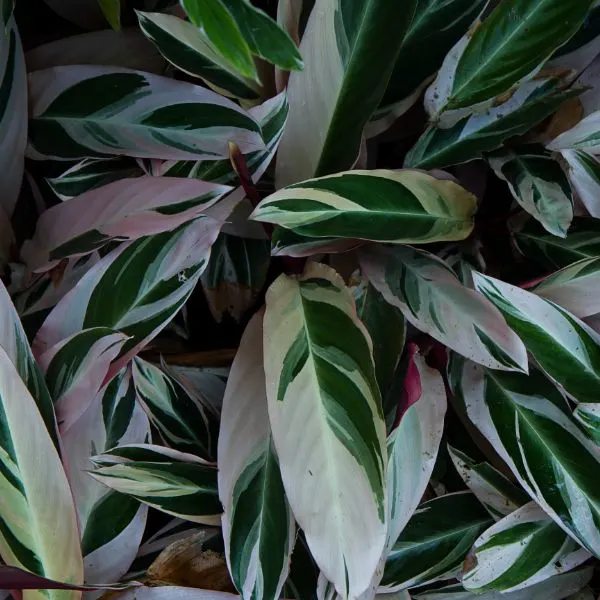
Commonly known as giant bamburanta or never never plant, Calathea oppenheimiana is native to northeast Brazil. It is colorful and attractive, sometimes growing up to any height between 54 and 90 cm (21.2 and 35.4 in).
The leaves of this species are smooth, hairless and attractive. They are long, narrow and tapering to a pointed apex. On its upper surface, a never never plant leaf is light green, with dark green patterns on it and silver bands.
The underside is often a purplish red color. This leaf is usually more than 15 cm (6 in) long and between 7.6 and 15 cm (3 and 6 in) wide. The leaves of Calathea oppenheimiana often overshadow its tiny flowers.
Its small flowers may be white, gold or yellow in color, and they grow in clusters. They are shaped like a short funnel, made up of two or three sepals and two or three petals. They are insignificant and not typically seen in cultivation.
Never never plants need sunlight for their growth but this must reach them indirectly. They may be kept in a bright room, as dimly lit settings starve them of sunlight. They may also be kept under glass to regulate sunlight levels.
Growing them under glass may also help keep temperature and humidity levels fairly uniform. Because they are tropical plants, they require warm temperatures and medium to high humidity, preferably at constant levels.
For soil requirements, Calathea oppenheimiana needs moist soil which drains well-drained soil. It must be watered with moderation but regularly. When your plant lacks adequate water supply, its leaf margins may brown and begin to curl.
When it is watered too much, its leaves may begin to turn yellow and the plant’s roots are likely to rot. Watering should be done with distilled or filtered water, as buildup of salt and minerals from the use of tap water causes leaves to brown.
Pruning and the use of fertilizer are not required. However, you may use fertilizer once a month during the growth cycle of the plant. It may be repotted once every year, preferably in the spring or early summer.
10. Calathea roseopicta
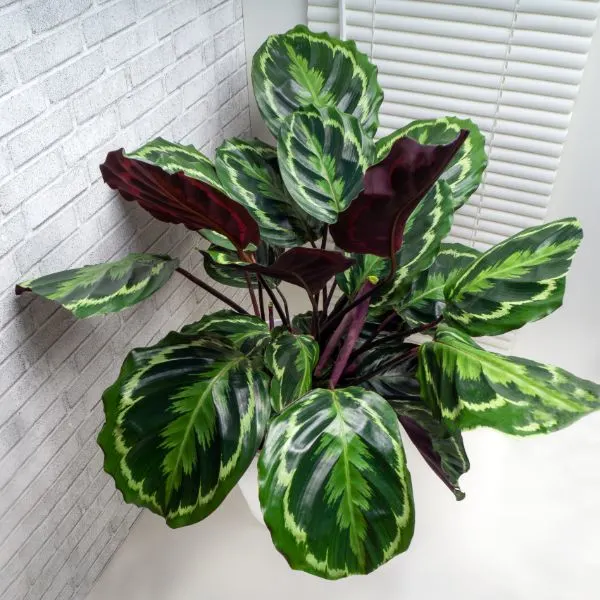
The rose-painted calathea is one of the most beautiful types of calathea. Its large leaves are glossy with bright green to creamy patterns. They are round and have very long leaf stalks. They are almost as wide as they are long.
Several varieties of this species exist, and the most popular are: Corona, Cynthia, Dottie, Medallion and Rosey. The rarest cultivar of this species has white and green leaves and a pinkish rose color on the front side of the leaves.
Each variety of Calathea roseopicta has a unique coloration pattern. Nonetheless, they all have a “crown” of color that runs around the entire leaf margin. It creates the illusion of a leaf within a leaf.
While the leaves are reddish or purplish in color underneath, the top sides of the varieties are commonly colored green, silver, pink or purple. Some individual plants have been observed at up to 76 cm (30 in) tall.
The small flowers of this plant are white and purple and they blossom in the summer. To ensure that the leaves do not get discolored, fade or turn brown, it is important to care for your plant and provide its adequate requirements.
Place it in a well lit area where it receives enough sunlight to aid photosynthesis, but indirectly. Water it regularly with filtered or distilled water. Be careful not to overwater or underwater your plant.
Rose-painted calatheas require high humidity and warm temperatures. These levels should be relatively steady to ensure the plant thrives. Regular use of humidifiers and misting help increase humidity levels around it.
The soil they are planted in must have high water retention capacity and also be able to drain well. Repotting is advisable once a year to replenish the plant’s nutrients from the soil and give the roots more space for growth.
11. Calathea zebrina

Native to Brazil, Calathea zebrina is more often called the zebra calathea or zebra plant. It owes this common name to its leaf patterns which resemble the skin of a zebra. They are dark to mid-green stripes on an almost neon green backdrop.
Its leaves are oblong, thick and velvety. They may grow to over 30.5 cm (12 in) wide. In the spring, its purplish white flowers bloom, but this is rare when grown indoors. At maturity, the plant may grow up to 60 cm (24 in).
Place the plant in an illuminated area with filtered or indirect sunlight. Scorching is likely to happen as a result of exposure to direct sunlight. Water it once or twice a week according to its preferences but do not let it dry out before watering again.
The level of the temperature around it should be kept stable and warm. Zebra calatheas, like other calathea species, require medium to high humidity levels which can be created and sustained by regular misting and use of humidifiers.
The potting soil used to grow this species may be mixed with gravel, fine sand or perlite to help with its drainage ability. The soil should be able to hold just enough water and also drain out the excess easily.
Rare Types of Calathea
12. Calathea bachemiana
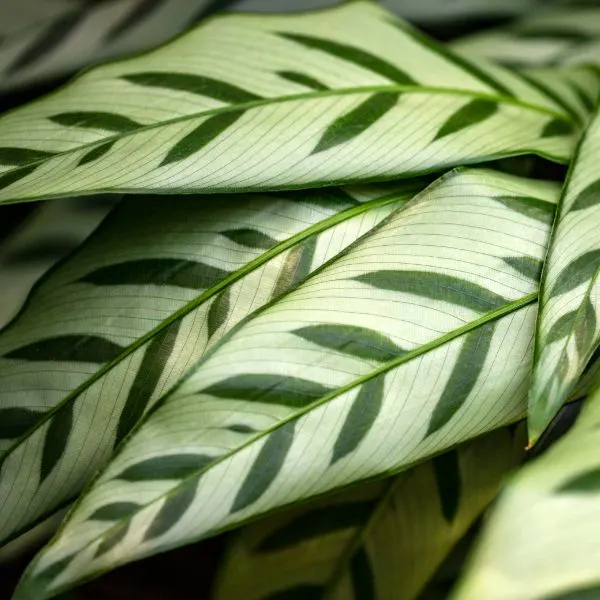
Calathea bachemiana is a rare calathea species native to Brazil. It has simple leaves which sit alternate to each other on the plant’s stem. They are egg-shaped, with a leaf stalk (petiole) joined to the broader end at the base of the leaf.
This species produces elongated clusters of tubular flowers in summer months. They require indirect sunlight for their growth, with medium to high humidity levels and warm temperature.
They must be watered frequently as they prefer moist but well-drained soil. This should be sandy loam, gritty loam or sandy clay soil that is rich in nutrients. The pot should have drainage holes and the plant may be repotted annually.
13. Calathea fucata
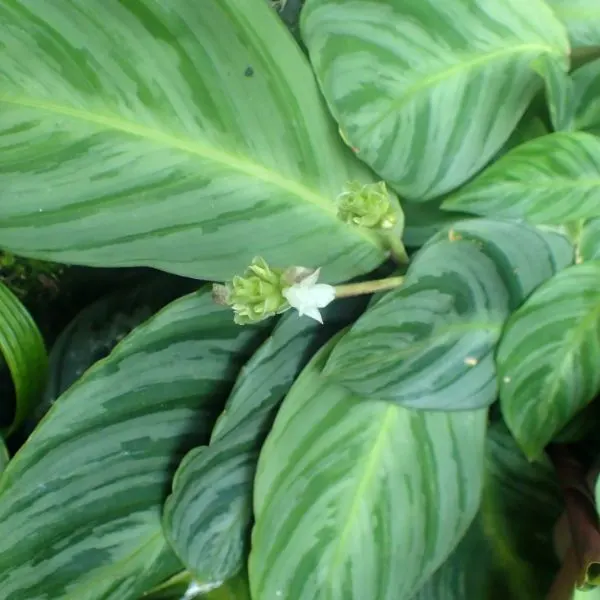
Another rare type of calathea is Calathea fucata, although it is quite popular. Its light green leaves have dark green stripes on them, and their underside is colored a lovely shade of purple.
This species may reach 60 to 90 cm (24 to 35.4 in) in height when fully matured. It produces white, yellow and purple flowers in the warmer months of the year, although this is not common in inbred plants.
Calathea fucata needs luminous environment but indirect sunlight to encourage photosynthesis, maintain leaf color and patterning, and discourage the scorching of leaves. It should also be grown in high humidity.
Never let your plant dry out before watering it again as it likes being consistently moist. Depending on other factors, it should be watered once or twice a week or more with distilled or filtered water (it is sensitive to chemicals in tap water).
It may develop brown spots or its leaves may become crisp as a result of chemical burn. The plant requires soil that both drains well and retains moisture. It responds negatively to low temperature and frequency of watering should be reduced in colder months.
14. Calathea leopardina

Another popular but rare type of calathea is called Calathea leopardina, or more commonly “Calathea Freddie”. It is native to the tropics of South America but is most commonly found in Brazil.
Its upright stem may grow up to 60 cm (24 in). Its leaves may be as long as 12 to 17 cm (5 to 7 in). This plant is easily maintainable as it is a low maintenance species. Its growth and care requirements are similar to many other calatheas’.
Calathea leopardina requires bright indirect sunlight or medium light. It likes constant soil moisture and should be watered if: the leaves are drop, the top soil is dry, the leaves are wrinkling or the leaf edges are yellowing or browning.
The plant also requires substantial amounts of humidity. High humidity is recommended, and this can be ensured by using a humidifier or moving the plant to a more humid space like a bathroom or kitchen.
It requires warm temperature. It is imperative to regulate the temperature levels in its surroundings, ensuring the area is not too cold. This is because the plant does not recover from the damage that comes as a result of constant cold.
Provide your plant with soil mix that drains easily and is able to hold moisture but not too much moisture as soggy soil leads to root rot. Balanced nitrogen rich fertilizer may be used every 4 to 6 weeks in warmer months but not in the winter.
Repot your calathea when you notice roots sticking out of the pot’s drainage holes. This should be done only in the spring or summer when it is actively growing. This may be done anually or biannually.
15. Calathea lietzei
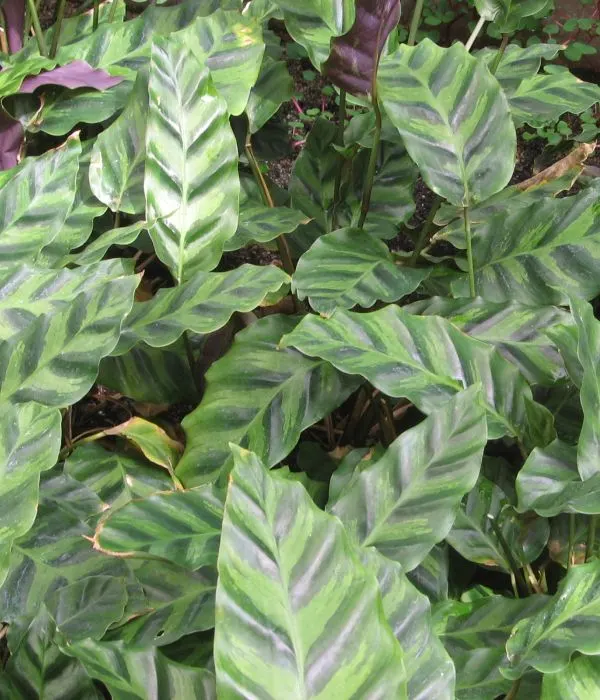
This species is also known as the white fusion calathea. It is rare, with lanceolate (narrow and tapering to a pointed apex like a lance head) leaves. Their top side is green with white and silver stripes, while their underside is a deep maroon.
A fully matured Calathea lietzei plant is usually 30 to 60 cm (12 to 24 in) long. For optimal growth, it requires adequate sunlight. It should be placed in a well lit room where sunlight does not reach it directly, near an east or west facing window.
Water your plant before it completely dries out, preferably when the top soil feels dry. This should be done with filtered or distilled (rain) water. The plant’s soil should be moist but not soggy to avoid root rot.
Calatheas do not like dry air, and the white fusion calathea is no exception. Mist your plant regularly or use a humidifier, especially during colder months of the year, to keep humidity levels high and fairly stable.
For healthy and maximum growth, it requires neutral or slightly acidic soil that is able to retain moisture but is well draining also. Mixing store-bought potting soil with perlite, gravel or sand can help with the soil’s drainage capacity.
Calathea lietzei grows very slowly and so it may need to be repotted only once every two or three years. Getting the plant to flower requires special treatment. Its flowers are usually white and small compared to its large leaves.
16. Calathea louisae
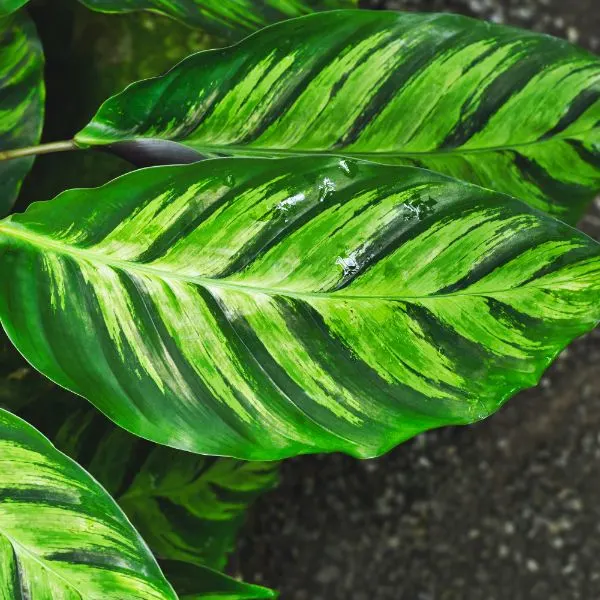
With origins in Brazil’s rainforests, this type of calathea is more commonly known as the Thai beauty. Its most apparent and attractive part — the foliage — is green above with yellow and deep green stripes and a purple underside.
The tropical plant needs to be taken care of as though it lives in the rainforest. It requires high humidity (moist air) and warmth. It also needs to be watered regularly to ensure that the soil is always slightly moist.
Bright, indirect sunlight helps this plant grow. If it is exposed to dry air, low temperature, overwatering and direct sunlight, the beautiful leaves may be damaged by browning or scorching, and the roots may begin to rot.
Calathea louisae appreciates well drained soil that is also able to retain enough moisture for its growth. Soil with high amounts of fluoride should be avoided. In addition to your potting mix, put in perlite, compost and peat.
When your prayer plant is dormant in the winter months, you’ll want to increase the frequency of watering to every other day, about 3-4 times a week. However, you should decrease the amount of water you use.
As opposed to tap water, use filtered or distilled water for your calathea. Ensure the soil is always moist but not soaked with water by using a pot with drainage holes. Keep humidity levels around the plant high by misting the plant or making use of a humidifier.
Warm temperatures and using fertilizer sparingly are good for your Thai beauty. Repot it every spring until it is at least four years old. After this time, you can begin to repot it once every two years.
It needs to be repotted when the roots are overgrown, or the leaves start wilting, or the plants growth rate starts to reduce. Pruning is not needed but it could encourage flowers to bloom. Removing infected leaves is important nonetheless.
17. Calathea lutea

Calathea lutea is another popular but rare species of prayer plants. It is also known by such names as cigar calathea, Cuban cigar, Mexican cigar plant and Pampano plant. It is native to Mexico and the Caribbean.
It is easy to care for and has similar requirements to most of the other calathea types. The leaves of the plant are large, broad and a vibrant green color. With care and provision of requirements, the plant produces dark waxy red flowers.
Cigar calatheas do not like direct exposure to sunlight. They instead prefer to be kept in a bright room with shade, so that they are able to receive indirect sunlight. They grow to different sizes, usually around 70 cm (28 in).
A plant of this species requires medium watering. It should be watered only when the top of the soil feels dry. It however must not be left completely dry, or overwatered, as both have adverse effects on it.
It needs rich, moist soil that is also able to drain well. The soil should be slightly acidic to neutral, with high organic material. For the best results, use a fertilized potting mix which has peat moss, coir, compost and vermiculite or perlite.
If you would like to make use of fertilizer, it is advisable to use organic plant feed but not in the winter. Although this plant can stand moderate humidity levels, it thrives in the presence of highly humid areas. Misting it regularly helps.
Cigar calatheas fare better in warmer temperatures. They may grow to very large sizes and are prone to being root bound. For this reason, they need to be repotted biannually, in the spring or summer. They are toxic plants.
18. Calathea majestica
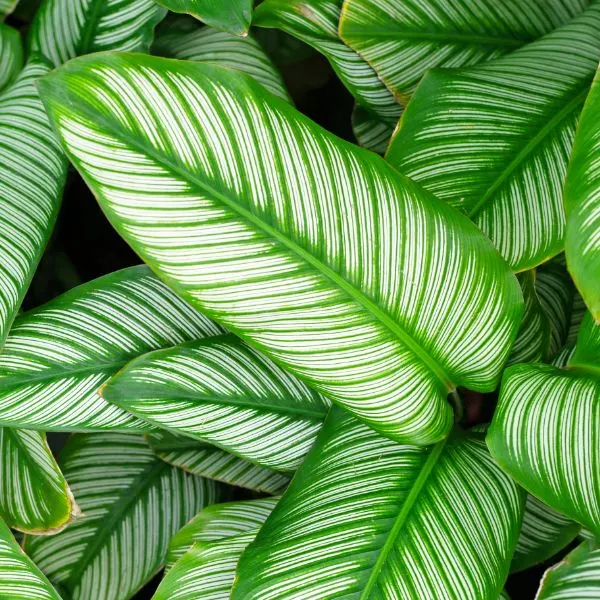
This is more commonly known as the white star calathea. It is a rare and very unique calathea species. Its leaves are very large, much larger than those of most plants in its genus, and they are predominantly white, not green.
Calathea majestica needs indirect sunlight for photosynthesis and consequently, growth. Its soil should be kept moist but neither dry or soaked. If you touch the top soil and it feels dry, it is likely time to water the plant.
Its soil preference is a mix that is well fertilized, rich with nutrients, lightweight, moderately moisture retentive and well-draining. It may be fertilized once every month, except in the winter, for optimum results.
Warm temperatures and moderate to high humidity levels do white star calatheas good. These should be regulated and kept fairly stable, but the plants should be kept away from air vents or heaters.
Placing this calathea in a bathroom in which the environment is more moist, misting it regularly or making use of a humidifier can help give your plant more adequate moisture. It grows moderately fast but do not produce flowers.
19. Calathea micans

Calathea micans is a low growing plant, reaching heights of 5 to 8 cm (2 to 3.15 in). It is evergreen, with simple green leaves. The leaves are large, broad and egg-shaped, with long petioles (leaf stalks).
In the summer, this calathea blooms and produces elongated clusters of flowers. These flowers are white and usually shaped like a funnel. This species is native to Central America and the tropics of South America.
Take care of it like other calatheas. Provide Calathea micans with indirect sunlight, enough but not excess moisture, rich, moist and well-drained sandy loam, gritty loam or sandy clay soil, warm temperatures and high humidity levels.
20. Calathea orbifolia

This popular but rare species is more commonly referred to as round-leaf calathea, orbit peacock plant or South American prayer plant. It has very large leathery leaves distinguished by cream colored and light green stripes.
These round leaves grow as wide as 20 to 30.5 cm (8 to 12 in) and are slightly wavy along their lateral veins. The entire plant may grow up to 91 cm (36 in) high. It is one of the larger species of calathea.
Like other tropical plants, the round-leaf calathea requires bright indirect sunlight, high humidity, warm temperatures, just enough water to keep its soil moist but not water logged, and well-draining soil.
To discourage the curling, crisping or browning of leaves, use a humidifier, move your plant to a more humid place or mist it regularly, ensure it is watered with only distilled or filtered water, and keep it away from direct sunlight.
When your Calathea orbifolia has grown to maturity, it will begin to produce small, white flowers on a short flower spike. Repot it when roots begin to grow out of the drainage holes in the pot, preventing the roots from being bound or crowded.
21. Calathea ornata

Native to Colombia and Venezuela, Calathea ornata is known also as the pin-stripe calathea. Its large leaves are oblong and dark green in color. Growing to as long as 30 cm (12 in), they have pinkish or silvery white stripes on their stems.
Underneath them, the smooth, stiff leaves are reddish purple in color. Individuals differ in foliage volume as some plants have slender foliage while some are bushy. This calathea is rare to find although it is a easy to take care of.
Pin-stripe calatheas may grow up to 60 cm (12 in) tall. Mature ones have their undersides change to a deep green color. These plants have similar requirements to most of the other species in their genus.
They require bright but indirect, adequate water, rich and moist but well-drained soil, high humidity, warm temperature, and distilled or filtered water. These keep the plant healthy and help it grow properly.
At maturity, pin-stripe calatheas produce orange flowers. A cultivar of this species exists, called Calathea ornata ‘Sanderiana’. It resembles Calathea ornata but its leaves are shorter and rounded than its parent plant’s.
22. Calathea pavonii
Calathea pavonii, or red star calathea, is a very rare species with a very rare appearance. It has large dark green leaves with dramatic pink and purple patterns. These patterns are diamonds- or square-shaped instead of striped like others.
The red star calathea is native to Brazil. Its large leaves are slightly ruffled, and when the plant is mature, it produces small, white flowers that grow in clusters. This beautiful tropical plant should be taken care of properly.
Ensure that its environment is bright, warm and humid. Water it regularly, enough that it is neither dry nor water logged, and provide it with indirect or shaded sunlight. Mist it regularly and grow it in moist but well drained soil.
23. Calathea picturata
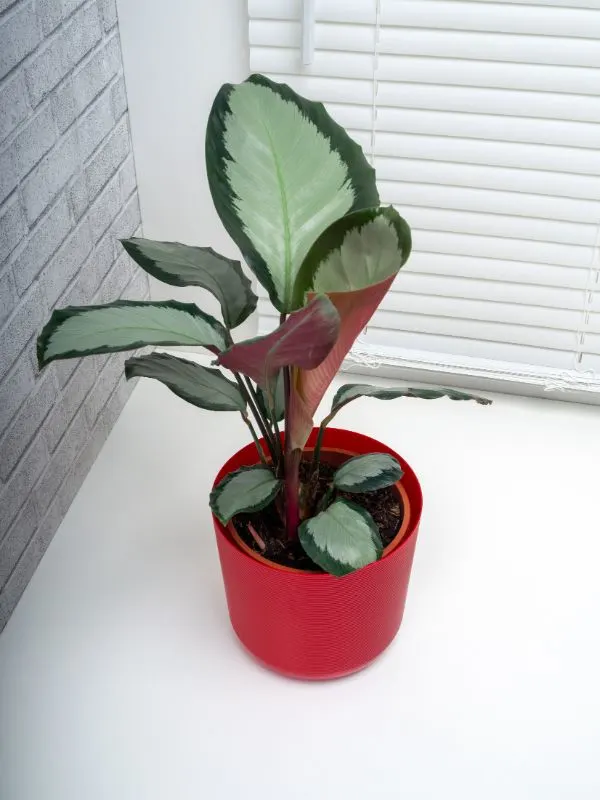
The species known as Calathea picturata is rare but distinct as a result of an intense color in the centre of its leaves surrounded by green color. Two main types of this calathea exist: the crimson and the silver.
Although it requires some more care than other house plants, it is not extremely difficult to look after. It should be watered regularly, before the soil dries out. Underwatering causes the leaves to droop and overwatering causes them to yellow.
Filtered or distilled water is ideal for watering. Medium or bright indirect sunlight aids photosynthesis and consequently growth. If your plant’s leaves begin to curl, it is receiving too much or direct sunlight.
Calathea picturata thrives in humid and warm conditions, which can be enhanced by making use of a humidifier. It also requires balanced soil that retains moisture but also drains easily. Add orchid bark and perlite to your potting mix to help.
The leaves of plants of this species may burn if a strong fertilizer mix is used for them because they are sensitive. If you choose to fertilize still, use a diluted fertilizer. Apply it only when the plant is actively growing, never in the winter.
24. Calathea rufibarba

More commonly referred to as velvet calathea or furry feather calathea, Calathea rufibarba is native to Brazil. Its leaves are easily distinguishable from those of other species in its genus because of their more subtle patterns and underleaf texture.
Its leaves are long, lanceolate, slender and wavy. The top side is green in color while the underside is maroon to burgundy in color, with a fur-like texture. The leaf stalks and the plant’s stems are also burgundy in color.
Velvet calatheas may grow as high as 91 cm (36 in). Same as other calatheas, they need indirect sunlight or bright but shaded lighting conditions. They need warmth and high levels of humidity.
These plants also need constant moisture levels. Depending on other factors, they need to be watered enough that the soil is neither soaked nor dried out. Use filtered or distilled water and a pot with drainage holes.
Calathea rufibarba has dense, fuzzy leaves that need to be cleaned more regularly and carefully. This can be done by light showering, misting or wiping with a soft, damp cloth. Avoid using tap water and trim out dried leaves.
Because this species does not require fertilizer for optimal growth, use minimal amounts of fertilizer sparsely. If the plant begins to outgrow its pot or lack nutrients, it needs repotting. Repot annually or biannually.
25. Calathea warscewiczii

Another popular but rare type of calathea is called Calathea warscewiczii, or jungle velvet calathea. It grows lanceolate leaves which are large in size, velvety to the touch and dark green in color, with light green patterns on their top surface.
The long leaves may be longer than 30 cm (12 in) at maturity and they possess white or silver stripes. Their undersides are typically violet or deep purple in color. The entire plant is large, growing up to 91 cm (36 in).
As other calathea types, this one needs rich and well draining soil, adequate moisture, bright but indirect sunlight sources, warm temperature, high humidity levels and repotting every one or two years.
At maturity, jungle velvet calatheas produce creamy yellow and white flowers on long flower spikes. They do not need too much fertilizer to grow well. While watering and cleaning them, use filtered or distilled water.
Other Less Popular Types of Calathea
Other species or types of calathea exist and they are less popular than those listed above. Unfortunately it was difficult to source images and information on them so we will just list them out. According to Wikipedia, some are:
26. Calathea asplundii
27. Calathea barryi
28. Calathea brenesii
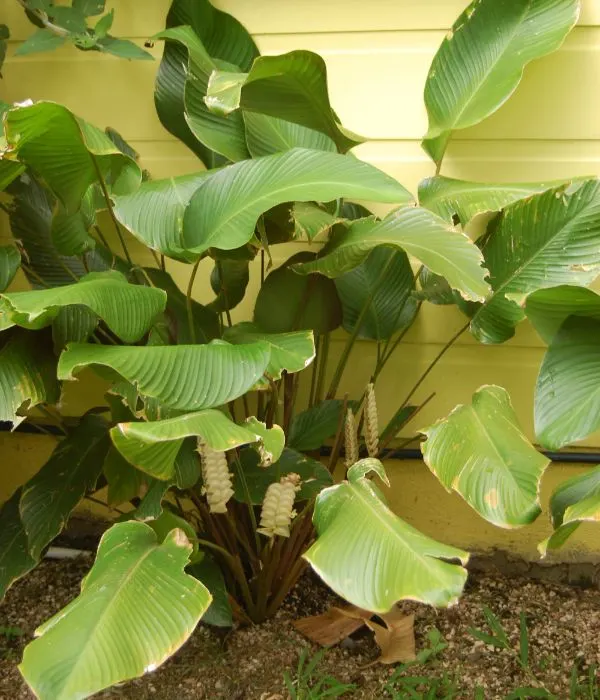
29. Calathea caesariata
30. Calathea calderon-saenzii
31. Calathea carlae
32. Calathea casupito
33. Calathea chiriquensis
34. Calathea cofaniorum
35. Calathea confusa
36. Calathea congesta
37. Calathea croatii
38. Calathea ecuadorina
39. Calathea elliptica
40. Calathea erythrolepis
41. Calathea fredgandersii
42. Calathea fredii
43. Calathea galdamesiana
44. Calathea gentryi
45. Calathea grandifolia
46. Calathea guzmanioides
47. Calathea gymnocarpa
48. Calathea hagbergii
49. Calathea harlingii
50. Calathea inscripta
51. Calathea ischnosiphonoides
52. Calathea jondule
53. Calathea lanibracteata
54. Calathea lanicaulis
55. Calathea lasiostachya
56. Calathea lateralis
57. Calathea latrinotecta
58. Calathea loeseneri
59. Calathea macrosepala
60. Calathea marantifolia
61. Calathea monstera
62. Calathea multispicata
63. Calathea neillii
64. Calathea neurophylla
65. Calathea nitens
66. Calathea oscariana
67. Calathea platystachya
68. Calathea plurispicata
69. Calathea ravenii
70. Calathea recurvata
71. Calathea retroflexa
72. Calathea rubribracteata
73. Calathea shishicoensis
74. Calathea similis
75. Calathea spiralis
76. Calathea striata
77. Calathea stromanthifolia
78. Calathea tarrazuensis
79. Calathea timothei
80. Calathea toroi
81. Calathea trianae
82. Calathea truncata
83. Calathea undulata
84. Calathea utilis
85. Calathea velutinifolia
86. Calathea verruculosa
87. Calathea wiotti
88. Calathea yawankama
Video of the most popular types of Calathea plants
FAQs
How do you care for Calatheas?
To care for calatheas, provide them with conditions similar to tropical regions. Water them regularly and adequately, place them in highly humid areas, keep temperature levels around them stable and warm, make use of moist but well drained, rich soil, clean their leaves, cut away dried out leaves and repot them when their roots begin to grow out from the pot’s drainage holes.
Does Calathea need sunlight?
Yes, calatheas need sunlight, no matter the species. It is required for photosynthesis, the process that provides them with energy and helps them grow. However, direct sunlight causes them damage, scorching their leaves and causing them to curl. To discourage this, keep them in well lit spaces where they receive indirect or shaded sunlight.
Is Calathea good for indoors?
Calatheas are good indoor plants. If left outdoors, they are prone to scorching, curling and drying out.
Where should I place my Calathea?
Place your calathea in an illuminated room where they are able to receive indirect sunlight. It is recommended to keep them about three or four feet away from an east or west facing window. It helps if they are placed in a bathroom or kitchen — any humid environment.
Conclusion
There are about sixty (60) species of plants currently in the genus Calathea. There were formerly well over two hundred (200) but some have been moved to the genus Geoppertia. They are still however popularly considered calatheas.
Listed and explained above are eleven (11) species of common and popular calatheas. Fourteen (14) more species that are rare are briefly explained, and sixty three (63) less popular species are listed.
Calatheas are evergreen perennial plants (plants that last up to or more than three growth seasons). They are popular as house or office decoration plants because of their large and very attractive leaves with striking patterns.
Most types of calathea are not toxic to humans and animals. Their leaves are of some importance to several herbivores, like the caterpillars of the purple owl. Spider mites, fungus gnats, thrips and mealybugs also feed on and damage them.
When they begin to overgrow their containers, these plants are expected to be carefully repotted. The new container should be no more than one or two inches larger than the older pot to avoid shock and withering.
Several species of calathea are threatened with extinction due to habitat damage. Their leaves are prone to destruction by pests but quite resistant to diseases. If they are overwatered, they face higher risk of disease.
In the native range of the plant, its large leaves are popularly used to hold small items. Unprocessed, they are used to wrap fish for transport in Brazil. Calathea leaves are also used for decorative purposes.
They are processed and used to produce containers by hand in som other places like Colombia. In Thailand, they are used decoratively to make rice containers. These are sold to locals and tourists, making them an important source of income.
Outside the tropics, they are most popularly used as decorative or ornamental indoor plants. They are typically grown in the home or the office. They are very beautiful plants that usually have striking foliage and require attention.
Check out more types of things
